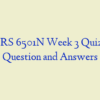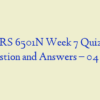Description
NURS 6501N Week 3 Quiz with Answers
- A nurse should document on the chart that chronic pain is occurring when the patient reports the pain has lasted longer than:
- A teenage boy sustains a severe closed head injury following an all-terrain vehicle (ATV) accident. He is in a state of deep sleep that requires vigorous stimulation to elicit eye opening. How should the nurse document this in the chart?
- A 75-year-old female suffers a stroke and now has difficulty writing and production of language. This condition is most likely caused by occlusion of the:
- A 69-year-old male with a history of alcohol abuse presents to the emergency room (ER) after a month-long episode of headaches and confusion. Based on his alcoholism, a likely cause of his neurologic symptoms is:
- A 65-year-old male recently suffered a cerebral vascular accident. He is now unable to recognize and identify objects by touch because of injury to the sensory cortex. How should the nurse document this finding?
- Which system modulates a patient’s perception of pain?
- An initial assessment finding associated with acute spinal cord injury is _____ the injury.
- A 20-year-old male suffers a severe closed head injury in a motor vehicle accident. He remains in a vegetative state (VS) 1 month after the accident. Which of the following structures is most likely keeping the patient alive?
- A 15-month-old child from Pennsylvania was brought to the ER for fever, seizure activity, cranial palsies, and paralysis. Which of the following diagnosis will be documented in the chart?
- A patient with an addiction to alcohol checked into a rehabilitation center. He experiences delirium, inability to concentrate, and is easily distracted. From which of the following is he most likely suffering?
- When a patient has a peculiar sensation that immediately precedes a seizure, what term should the nurse use to describe this sensation?
- A 20-year-old male was brought to the emergency room (ER) for severe burns. He requested something for the excruciating pain he was experiencing. Blocking which of the following neurotransmitters would reduce his pain?
- A 15-year-old male is brought to the ER for treatment of injuries received in a motor vehicle accident. An MRI reveals spinal cord injury, and his body temperature fluctuates markedly. The most accurate explanation of this phenomenon is that:
- A 72-year-old male demonstrates left-sided weakness of upper and lower extremities. The symptoms lasted 24 hours and resolve with no evidence of infarction. The patient most likely experienced a(n):
- When a patient has a fever, which of the following thermoregulatory mechanisms is activated?
- A 33-year-old male is brought to the ER for treatment of injuries received in a motor vehicle accident. An MRI reveals an injury of the cervical cord. Cord swelling in this region may be life threatening because:
- A 23-year-old female begins having problems with tiredness, weakness, and visual changes. Her diagnosis is multiple sclerosis (MS). What is occurring in the patient’s body?
- A 60-year-old female with a recent history of head trauma and a long-term history of hypertension presents to the ER for changes in mental status. MRI reveals that she had a hemorrhagic stroke. What does the nurse suspect caused this type of stroke?
- A patient has memory loss of events that occurred before a head injury. What cognitive disorder does the nurse suspect the patient is experiencing?
- A 20-year-old male was at the supermarket when he fell to the ground. Bystanders reported that he lost consciousness and his body tensed up then relaxed, then tensed and relaxed several times. He most likely was experiencing a(n):
- The nursing student would correctly identify the most common symptom of brain abscess as:
- Which finding indicates the patient is having complications from heat stroke?
- A 30-year-old female had a seizure that started with her fingers and progressively spread up her arm and then extended to her leg, with no loss of consciousness. How should the nurse chart this?
- A child presents to his primary care provider with disorientation, delirium, aggressiveness, and stupor. His parents report that he was recently ill with an upper respiratory infection, which they treated with aspirin. Which of the following is the most likely diagnosis?
- A 40-year-old male complains of uncontrolled excessive movement and progressive dysfunction of intellectual and thought processes. He is experiencing movement problems that begin in the face and arms that eventually affect the entire body. The most likely diagnosis is:













